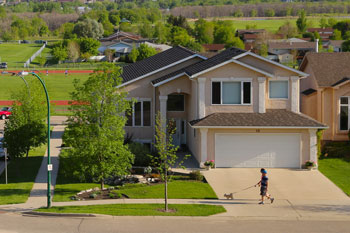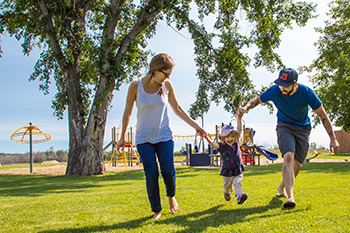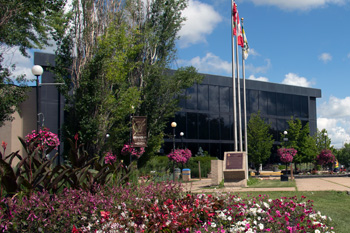Modern roundabouts are now a part of our roadway network in the City of Brandon. Utilizing these circular intersections is a unique and effective way to cope with increasing traffic demands on our roads by providing a safe and economical solution which reduces undesirable delays to motorists. This reduction in delays to motorists improves air quality and reduces greenhouse gas emissions by eliminating unnecessary stops and vehicle idling times.
What is a Modern Roundabout?
A modern roundabout is an intersection designed to control traffic in a circular flow. All traffic travels in a counter-clockwise direction around a central island. Vehicles entering the intersection must yield at entry to the roundabout, which means motorists may have to stop and wait for a gap in traffic before entering the roundabout. Drivers within the roundabout, including cyclists, always have the right-of-way. Multiple vehicles are permitted to travel in a roundabout at any given time, provided each motorist ensures safe distances are maintained between the vehicle they are following.

Structure of a Roundabout
(34th Street & Willowdale Crescent Intersection)
Turning Movements in a Roundabout
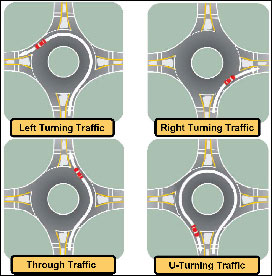
Safety of Roundabouts
Roundabouts are proving to be much safer than standard intersections around the world. Statistics show that roundabouts reduce fatal and injury related collisions by over 75%. Roundabouts are safer due to slower speeds and reduced conflict points (points where vehicles may collide with each other and/or with pedestrians). A comparison of the number of conflict points is represented in the two diagrams below, (16 for roundabouts versus 56 for standard intersections). Both vehicle-to-vehicle and vehicle-to-pedestrian conflict points are significantly reduced in the roundabout when compared to a standard intersection.

How to Drive in a Roundabout
- Slow Down when approaching a roundabout and watch for traffic signs;
- Yield to pedestrians at the crosswalk as you enter and exit the roundabout;
- Keep to the right of the “splitter islands”;
- Yield to ALL traffic in the roundabout that is approaching your entry point, (including cyclists), as they have the right-of-way over all other traffic;
- Look to the left for traffic and enter the roundabout only when it is safe to do so;
- Reduce Speed while traveling within the roundabout and exiting;
- Within the roundabout always travel counterclockwise and Do Not Stop; you have the right-of-way over entering traffic;
- Only Signal your exit as you approach your desired destination by using your right turn signal and taking the exit while maintaining a slow speed.
Roundabout Signs
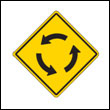
A "roundabout" sign indicates that motorists are approaching a roundabout intersection.
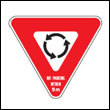
A "roundabout yield" sign indicates motorists must yield the right-of-way, stopping if necessary, before entering the roundabout and must not proceed until it is safe to do so.
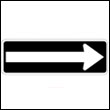
A "roundabout directional" sign indicates the direction for motorists to enter the roundabout and the counter clockwise traffic flow within the roundabout.
Pedestrian Guidelines
Roundabouts are designed to accommodate pedestrians by locating crosswalks approximately one car length prior to the yield sign. This allows the pedestrian to safely cross the road before the motorist becomes focused on entering the roundabout. Motorists are required by law to yield the right-of-way to pedestrians at crosswalks.
Pedestrians are encouraged to exercise due caution for their own safety when crossing crosswalks and should take full advantage of the “splitter islands” which allow pedestrians to cross one lane of traffic at a time. Pedestrians should not cut across the middle of roundabouts as motorists are not required by law to yield the right-of-way to pedestrians not utilizing crosswalks.
Cyclists Guidelines
Cyclists may either ride inside a roundabout or dismount and walk their bicycle across the crosswalks. Experienced cyclists may choose to cycle through a roundabout; however they must follow all the rules of the road as they pertain to vehicles. Since traffic in the roundabout is generally slower, cyclists should be able to travel at or near the same speed as motorists, staying in line with the counter-clockwise traffic.
For less confident cyclists, please dismount your bicycle and walk across the crosswalks to safely maneuver the roundabout. Follow the guidelines as listed above for pedestrians.
What about Emergency Vehicles?
If you have not yet entered the roundabout, pull to the right side of the road and allow the emergency vehicle to pass you on the left. If you have entered the roundabout, continue on at a safe speed within the roundabout and exit as normal, then pull to the right side of the road and allow the emergency vehicle to pass you on the left.
DO NOT STOP WITHIN THE ROUNDABOUT FOR EMERGENCY VEHICLES.
Roundabout Rules Pamphlet
![]() Roundabout Rules Pamphlet (576 KB)
Roundabout Rules Pamphlet (576 KB)


